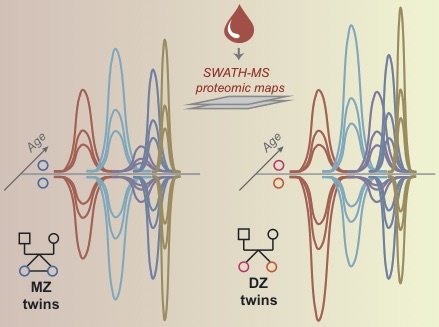Population level variability of plasma protein abundance
Researchers from the Aebersold group used a longitudinal twin strategy and SWATH mass spectrometry to characterize the quantitative variability profile of human plasma proteome.
The degree and the origins of quantitative variability of most human plasma proteins are largely unknown. The twin study design provides an opportunity to estimate the relative contribution of heritability and environment to different traits in human population. Here the IMSB researchers, together with the collaborators in University of Geneva Medical School and King’s College London, applied the highly accurate and reproducible SWATH mass spectrometry technique to quantify 1,904 peptides defining 342 unique plasma proteins in 232 plasma samples collected longitudinally from pairs of monozygotic and dizygotic twins at intervals of 2–7 years, and proportioned the observed total quantitative variability to its root causes, genes, and environmental and longitudinal factors. The data indicate that different proteins show vastly different patterns of abundance variability among humans and that genetic control and longitudinal variation affect protein levels and biological processes to different degrees. The data further strongly suggest that the plasma concentrations of clinical biomarkers need to be calibrated against genetic and temporal factors. Moreover, 13 cis‐SNPs significantly influencing the level of specific plasma proteins were identified. These results therefore have immediate implications for the effective design of blood‐based biomarker studies.
Ref: · Liu Y, Buil A, Collins BC, Gillet LC, Blum LC, Cheng LY, Vitek O, Mouritsen J, Lachance G, Spector TD, Dermitzakis ET, Aebersold R.Quantitative variability of 342 plasma proteins in a human twin population. Mol Syst Biol. 2015 Feb 4;11(2):786

